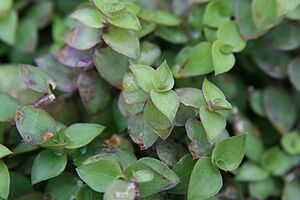Creeping inchplant facts for kids
Quick facts for kids Creeping inchplant |
|
|---|---|
 |
|
| Scientific classification | |
| Genus: |
Callisia
|
| Species: |
repens
|
Callisia repens, also known as the creeping inchplant, Bolivian Jew, or turtle vine, is a type of succulent plant. This means it has thick, fleshy parts that store water. It's a creeping plant, which means it grows along the ground. It belongs to the Commelinaceae family and originally comes from Central and South America.
What Does It Look Like?
This plant is a perennial, meaning it lives for more than two years. It forms thick, creeping mats on the ground. Its shoots grow upwards, and its leaves are soft and fleshy. The leaves get smaller towards the end of the shoot. Each leaf is shaped like an oval or a spear, about 1 to 3.5 centimeters long and 0.6 to 1 centimeter wide.
Callisia repens grows very quickly. It spreads easily using its long, creeping shoots. These shoots can grow roots at each node (a joint on the stem) as soon as they touch the ground. This helps the plant spread out and cover areas fast.
In the summer, the plant produces small, odorless flowers. These flowers grow in clusters called inflorescences, which are found near the top leaves of the flowering shoots. The flowers are hermaphrodite, meaning each flower has both male and female parts. They have small, white, spear-shaped leaves called bracts, which are about three to six millimeters long. Each flower can have up to six stamens (the male parts that produce pollen). The ovary (the female part that holds the seeds) has two sections. After flowering, the plant produces small, round fruits called capsule fruits. These fruits contain tiny seeds, about one millimeter in size.
Where Does It Grow?
This plant is originally from America. You can find it from the southeastern United States (like Texas and Florida) all the way down through the West Indies (including Guadeloupe and Martinique) to Argentina. It likes to grow in shady, rocky, or gravelly places in subtropical and tropical forests.
Callisia repens has also started growing in new places where it wasn't originally found. For example, it has become naturalized in Hong Kong, where it even grows on rooftops! In Western Australia, it's considered an invasive species. This means it spreads very quickly and can take over areas, harming local plants. Its fast growth, ability to live in different environments, and how it covers the ground allow it to spread rapidly. This can stop native plants from growing or even prevent their seeds from sprouting.
Growing Your Own!
People sometimes grow Callisia repens as an ornamental plant because it looks nice. It's very easy to grow new plants from cuttings. You just snip off a piece and plant it! It's also popular as a houseplant because its stems hang down, making it look pretty in hanging baskets. Its white flowers also have a pleasant scent.
If the plant gets a lot of bright light, its leaves might turn a bit reddish. It can even handle direct sunlight if there's enough moisture in the air. The best temperature for it to grow is between 18–22 °C during the day and at least 12°C at night. Be careful though, snails love to eat this plant!


